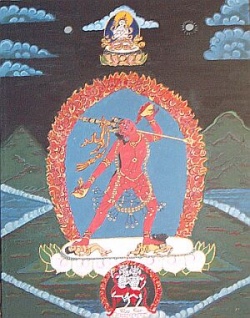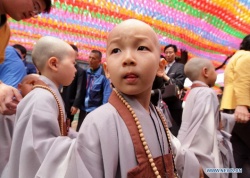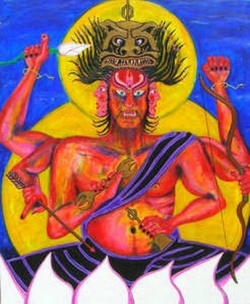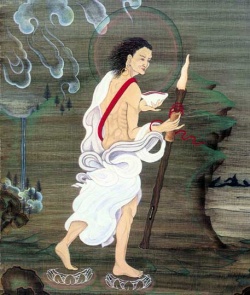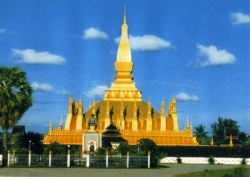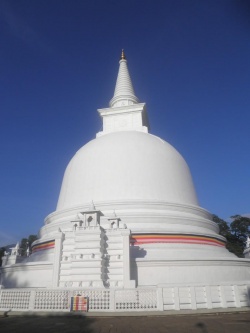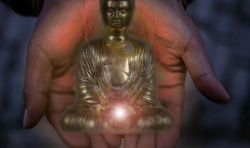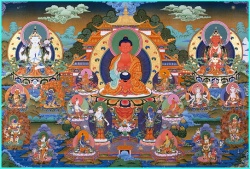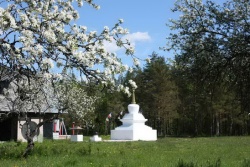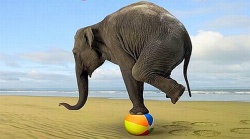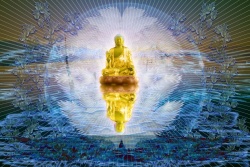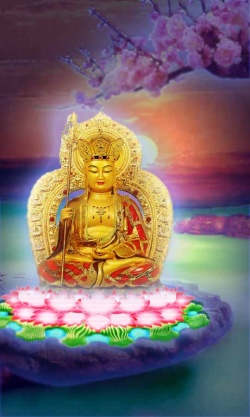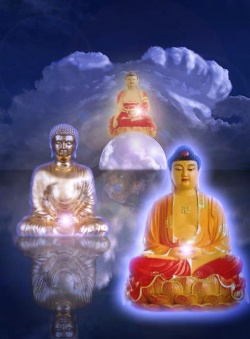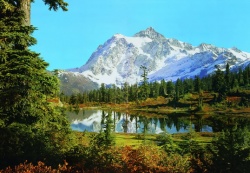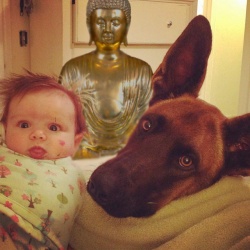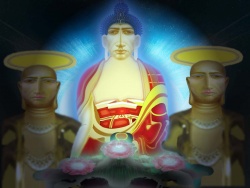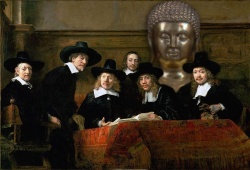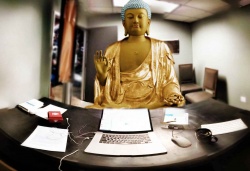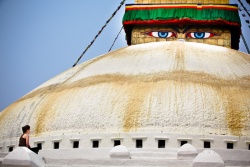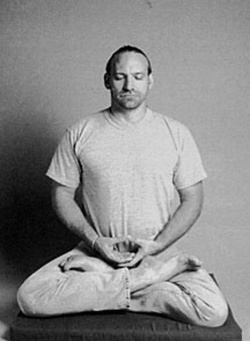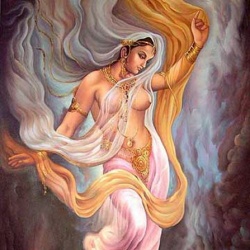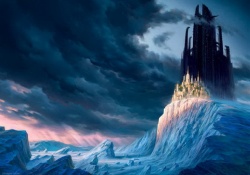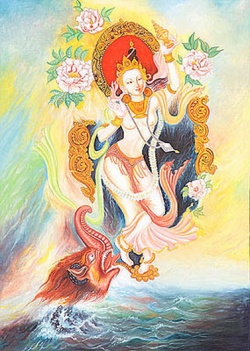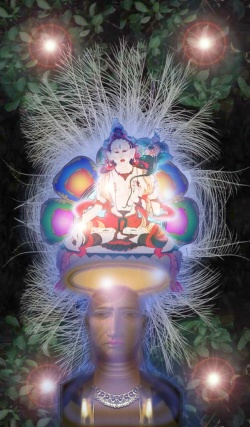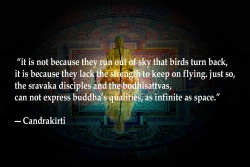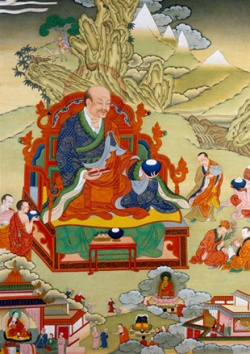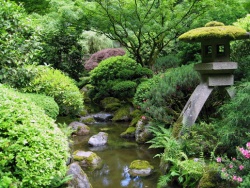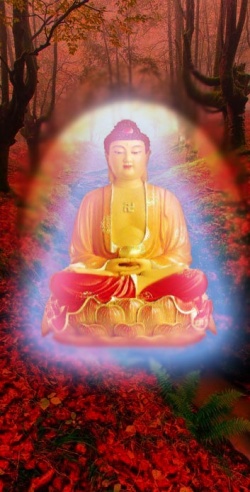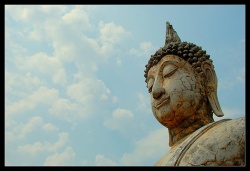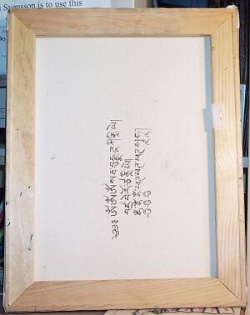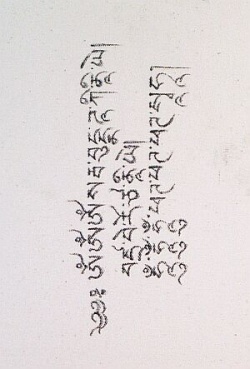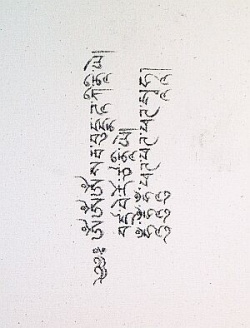A Monograph on a Vajrayogini Thanka Painting
Written by Julie O'Donnell, Pennie White B.A. Dip.Ed., Rilla Oellien and Evelin Halls
Consultants: John D. Hughes Dip. App. Chem. T.T.T.C. GDAIE
Need for Holding Precepts and Vows
This monograph is unsuitable for heretics who do not hold a minimum of five precepts of the Theravada tradition and a suggested minimum of 14 Tantric vows
.
The five precepts in Pali and English are:
Pancasila
Five Precepts
1. Panatipata Veramani Sikkhapadam Samadiyami
I undertake the rule of training to refrain from destroying living creatures.
2. Adinnadana Veramani Sikkhapadam Samadiyami
I undertake the rule of training to refrain from taking what is not given.
3. Kamesu Micchacara Veramani Sikkhapadam Samadiyami
I undertake the rule of training to refrain from wrong conduct in sexual pleasures.
4. Musavada Veramani Sikkhapadam Samadiyami
I undertake the rule of training to refrain from false speech.
5. Suramerayamajjapamadatthana Veramani Sikkhapadam Samadiyami
I undertake the rule of training to refrain from distilled and fermented intoxicants which are the occasion for carelessness.
Refer to Pali Chanting with translations.
The 14 Tantric vows (Vajrayana) are:
1. To not disparage one's Master
2. To not transgress the directives of the Buddha
3. To not express anger toward "Diamond Brothers"
4. To not abandon love of the sentient beings
5. To not abandon the Mind of Enlightenment
6. To not disparage the Doctrine of one's own, or of another's tenets
7. To not tell the secrets to immature persons
8. To not abuse the five skandhas for their nature belongs to the five Buddhas
9. To not have reservations concerning the natures intrinsically pure
10. To not have love for the wicked
11. To not apply discursive thought to the wordless natures
12. To not have belittling thoughts toward the believers
13. To not adhere to the pledges in the way they were taken
14. To not disparage women, who are the nature of insight. (Refer Conze)
This monograph has been sealed and protected by Tantric Deities. Refer to footnote 14.
In 2000 C.E., I chose to develop a thanka of Vajrayogini (1).
Available Literature
It is clear great beings follow her practices.
The essential meanings contained in her practices are to ‘Illuminate all hidden meanings’.
In the available English translated literature, I found few paintings of the deity or detailed writings about tantricas. This is understandable because the 7th Tantric vow is to not tell the secrets to immature persons.
A preordination was the first time this life I saw a brass image of Vajrayogini at the Buddhist Discussion Centre (Upwey) Ltd. Temple and heard the name of Vajrayogini. I had a natural affinity with this deity as if she stirred up memories of familiarity and affection.
My preliminary practice for 12 months was to adorn this Vajrayogini image with flowers. I selected fresh flowers from the grounds at our Centre and placed them on the image, often in her hair, on her shoulders, over her body to form a beautiful garment of flowers, on her feet, in her hands and between her thighs.
As I offered the flowers and placed them on the image, I clarified my mind and generated respect and gratitude. Each time the dana was offered, I would adjust my mind, and make sure that I knew what I was offering and who the offering was being made to.
In time, I was able to multiply the offerings from a single offering to hundreds of thousands of offerings with ease. I became aware of Vajrayogini and found I could know her mind and offer dana with no ritual or fantasy.
The ten blessings of offering flowers are: long life; good health; strength; beauty; wisdom; ease along the Buddha Dhamma path; being born in beautiful environments; born with good skin, hair and beautiful to look at; always having a sweet body; and pleasant relationships with friends.
I began to understand this natural affinity towards the deity because of past actions.
I generated the intention to meet with a living Vajrayogini in person one day or one night and be aware of her teachings and put them into practice in my own life.
Some Vajrayogini Teachings described here were a direct transmission from her minds to my minds rather than something read and understood with first or second order knowledge.
I now understand that because of my generation stage effort, I was able to complete a thanka of Vajrayogini and attain progressive understanding in the process.
It is the type of yearning you develop to be with a dear friend.
Later, I saw a sketch of Vajrayogini and began reading about Vajrayogini's teachings in a book by Geshe Kelsang Gyatso called Guide to Dakini Land.
I found there were many hundreds of thousands of Dakini students in the Vajrayogini heaven world. Recently, my Teacher told me there are millions of beings in that world. They look alike and all have the same minds.
I learnt about the charnal grounds inside the Vajrayogini mandala and what the different objects and beings symbolised.
Refer to endnote (15) I learnt of some of the qualities of Vajrayogini.
Vajrayogini is Queen of the Dakinis. She is able to subdue beings with strong attachment by sending her students to work in the world and teach beings who are teachable.
Vajrayogini has attained the ground of non-abiding nirvana, free from the extremes of cyclic existence and peace.
I learnt how she teaches beings to help others to practice Buddha Dhamma by overcoming obstacles. Vajrayogini teaches beings to practice the teachings taught by Buddha and provides protection and support during their training.
Her heaven world has many well trained devas and devatas who work for the welfare of other beings so that they may come out of suffering.
I learnt of how to enter a retreat to learn the Vajrayogini teachings. I learnt that it is possible for me to practice Vajrayogini Teachings as taught in this human life.
The retreat practices are well documented in ‘Guide to Dakini Land’ by Geshe Kelsang Gyatso.
Then, I researched Vajrayogini forms in the John D. Hughes Collection Library and found two more reference images suitable for my purposes.
The Fabric Used for the Work
I purchased medium grade canvas with dimensions of 25cm by 32cm that had been stretched onto a wooden frame and layered with a primer called Geso.
The total area of the canvas is 800 square centimetres.
The grade of the calico is 25.4 threads per inch and in metric, 10 threads per centimetre for the warp and 10 threads per centimetre for the weft. The finer fabric used for some of the thankas at our Centre have 76.2 threads per inch and in metric 30 threads per centimetre.
==Placement of Mantra==
The first thing to do with the work of painting, is to place a mantra of the deity or central character on the back of the work. This makes the mind of the painter stronger to contain the teachings of the subject.
I requested a local calligrapher to paint the Tibetan Vajrayogini mantra in black ink down a centre line on the back of the canvas. The mantra was painted in Tibetan.
==The Vajrayogini mantra reads:==
OM OM OM SARWA BUDDHA DAKINIYE VAJRA WARNANIYE VAJRA BEROTZANIYE HUM HUM HUM PHAT PHAT PHAT SOHA.
The first OM symbolises the Truth Body of all Buddhas, the second OM the Enjoyment Body of all Buddhas, and the third OM the Emanation Body of all Buddhas.
SARWA BUDDHA DAKINIYE literally means ‘All the Buddhas’ Dakinis’.
In this context, ‘Dakini’ is the inner Dakini, the clear light mind of a Buddha, and so SARWA BUDDHA DAKINIYE reveals that Vajrayogini is in nature the clear light mind of all Buddhas.
This does not literally mean that Vajrayogini has the same mind of a Buddha, but refers to her nature of clear light mind. Only a Buddha can have a Buddha mind.
VAJRA WARNAYNIYE means ‘Vajra speech Dakini’ and indicates Vajrayogini is in nature the vajra speech of all Buddhas.
VAJRA BEROTZANIYE means ‘Vajra Form Dakini’ and indicates Vajrayogini is the vajra body of all Buddhas.
Here, ‘vajra’ refers to great bliss inseparable from emptiness. Here again, we do not mean that Vajrayogini has the same Vajra Speech or Vajra Body of a Buddha. Only Buddha can have the Vajra Speech and Vajra Body of a Buddha.
HUM HUM HUM is a request to Vajrayogini: ‘Please grant me the blessings of your body, speech and mind so that I may attain the Vajra body, speech and mind’.
The Hum energises the request.
PHAT PHAT PHAT is the request: ‘Please pacify my outer, inner and secret obstacles’ Phat is known as the destruction Mantra. In this context, it is to destroy the outer, inner and secret obstacles so that the practitioner may have success.
SOHA conveys the request: ‘Please help me to build the foundation of all attainments’. (16)
Another translation of the mantra in Sanskrit is:
OM OM OM SARVA BUDDHA DAKINIYE VAJRA VARNANEYI VAJRA VAIROCHANEYI HUM HUM HUM PHATU PHATU PHATU SVAHA
OM OM OM is homage to Dharmakaya, Sambhogakaya and Nirmanakaya (19)
SARVA BUDDHA DAKINIYE - all the Buddha Dakinis, (Dakineyi refers to female wrathful and semi-wrathful deities)
VAJRA VARNANEYE - the Vajra Family to which the Dakinis belong
VAJRA VAIROCHANEYI - The Vairochana Vajra Tathagata Family of Dakinis. Vairochana Buddha. Vairochana Buddha is one of the five Buddhas of this Buddha Sasana. (18)
HUM HUM HUM - Vajra power or Vajra energy
PHATU PHATU PHATU destroys all mara or all obstructions
SVAHA - perfectly fulfilled.
The complete mantra means: Obeisance to all the Buddha Dakini, then Vajra Family Dakini, and then Vairochana Vajra Tathagata Family Dakini, Vajra Power, destruction of mara, perfectly fulfilled.
The central deities and settings were adapted from images in texts rather than directly copied to respect copyright laws.
==Paint Materials Used==
The paints used were Jo Sonjas Artists Quality acrylic water based paints which can be found at Ferntree Gully Art Supplies and most art suppliers.
The colours of the paints used in the work are chosen for their symbolic meaning (17).
The colours used in the work were warm red, indian red, cerealen blue, pearl white, green oxide, gold and ivory black. Gold paint is mostly used for decorations mainly for ornaments and backgrounds.
==The Placement of the Work==
This work depicts Vajrayogini as the central deity with Vajradhara above and Kinkara below.
It is traditional to place the original Teacher of a teaching at the top of the work. Vajradhara is painted above Vajrayogini because the Vajrayogini teachings were originally given to Vajradhara within the Heruka (5) Tantra.
The fire surrounding Vajrayogini is a manifestation of the five wisdoms of Vajrayogini and symbolises bodhichitta (6). Her right leg treads on the breast of Kalaratri (7) and her left leg treads on the forehead of black Bhairawa (8).
These are not the actual sentient beings, but manifestations of Vajrayogini's wisdom of bliss and emptiness appearing in the aspect of Kalaratri and Bhairawa.
They symbolise the maras of the delusions. Vajrayogini treads on Kalaritri and Bhairawa to demonstrate that she has destroyed her attachment, hatred and ignorance and is free from the fears of samsara and solitary peace.
Her whole Devata body is red because it holds her inner fire element. Her inner fire element causes her body to be pervaded by a bliss so that she can overcome obstructions.
Vajrayogini has a single face indicating her realisation that all phenomena are of singular nature.
She is a two arm form to represent her complete realisation of the two truths. Vajrayogini is painted with two eyes and a third eye on the ajana chakra revealing her ability to see everything in the past, present and future with her celestial eye.
In this work, she is looking upwards to the pureland of the Dakinis (9), demonstrating her attainment of outer and inner Pure Dakini Land (10) and indicating that she is also leading her followers to these attainments.
A curved knife (11) is held by her right hand to show her power to cut the continuum of the delusions and obstacles of her followers and of all sentient beings.
A skull cup (Sanskrit kapala) (12) filled with blood held in her left hand symbolises her experience of the clear light of bliss.(13)
Vajrayogini's left shoulder supports a khatanga showing that she is never separated from Heruka as she is depicted in yidam.
The khatanga represents Heruka and the various features of the khatanga are the sixty-two deities of Heruka's mandala (14).
The khatanga is octagonal in cross section, symbolising the eight great charnel grounds (15) of Heruka's mandala.
At the khatanga’s lower tip there is a single pronged vajra which symbolises the protection circle of Heruka's mandala. Towards the upper end of the khatanga there is a vase symbolising Heruka's celestial mansion.
Above this there is a crossed vajra symbolising the eight deities of the commitment wheel, and three human heads symbolising the deities of body, speech and mind.
Geshe Kelsang Gyatso writes that: ‘Vajrayogini's head ornament consists of a wheel, precious jewels, a tiara of human skulls and a vajra, together these symbolise the perfection of effort.
The ear ornaments represent the perfection of patience, the neck ornaments, the perfection of giving, the heart ornaments, the perfection of mental stabilisation and the ornaments of the arms and legs, the perfection of moral discipline.
Vajrayogini wears a garland of fifty human skulls representing her fifty purified inner winds.
Her black hair falls freely down her back to show that she is free from the fetters of self grasping and represents the unchanging nature of her Truth Body.
Vajrayogini is naked showing that she experiences bliss and that she bestows the siddhi of great bliss upon practitioners.’
The deities below the central image of Vajrayogini on a centre line are known as Kinkara or Citipati, Dhamma protectors also known as the Father-Mother Lord of the charnel grounds.
These protectors also represent death in its dancing form.
Other forms of death can be represented by bodies in various forms of decay, pictorial representations of possible rebirths such as hell, hungry ghost or animal.
Two figures are portrayed because death always deals with dualism; where there is death, rebirth must follow.
Endnotes.
(1) Vajrayogini - Sanskrit. Tibetan, rDo-rje-rnal -'byor-ma. A terrifying goddess-form emanation of Dhyani Buddha Ratnasambhava.
A dakini, and goddess of initiation who personifies the female wisdom energy of emptiness. She generally appears naked crushing underfoot the Hindu god Bhairava and is functionally equivalent to Vajravarahi.
In her red form:
Face: one, fierce, arms/hands: four, holding tantric staff (danda, hprul-gyis), curved knife, thunderbolt (vajra, rdo-rje), skull-cup (kapala, thod-pa) and club; color: red; emanation of Dhyani Buddha Ratnasambhava. p.597
(2) Citipati - Sanskrit.
Chinese, Fen-chu ju-fa; Tibetan, Dur-krod-bdag-po. A pair of dancing skeletons who are enemies of thieves. As Kinkara, known as the Father-Mother Lord of the charnel grounds.
(3) Vajradharma - Sanskrit, Chinese, Chin-kang-fa, Chin-kang-miao-fa; Tibetan, rDo-rje-chos. A form of Dhyani Bodhisattva Avalokitesvara.
(4) Vajradhara - Sanskrit. Mongolian: Ocirdara, Vacir bariqci, Vcir-dhar-a; Tibetan: Do-rje 'chang, rDo-rje hchan. The tantric manifestation of Sakyamuni Buddha, and the anthropomorphic representation of Adi-Buddha.
When in the yab-yum pose with shakti, they represent that the distinction between "Duality and Oneness Absolute".
(5) Heruka - Sanskrit. A terrifying emanation of Dhyani Buddha Aksobhya. In Tibet he is considered an Istadevatas. He is believed to confer Buddha-hood.
(6) Bodhicitta - Sanskrit.
The Sanskrit word for ;mind of enlightenment’. ‘Bodhi’ means enlightenment, and ‘chitta’ means mind.
There are two types of bodhichitta: conventional bodhichitta and ultimate bodhichitta.
General speaking, the term ‘bodhichitta’ refers to conventional bodhichitta, which is a primary mind motivated by great compassion that spontaneously seeks enlightenment to benefit all sentient beings. Conventional bodhichitta is of two types: aspiring bodhichitta and engaging bodhichitta.
Ultimate bodhichitta is a wisdom motivated by conventional bodhichitta that directly realises emptiness, the ultimate nature of phenomena.
(7) Kalaratri - Sanskrit. Mongolian, Yam-a eke; Tibetan, gShin-rje-dus-mtshan-ma. A deity who is in the retinue of Camundi pictured in the Mongolian Kanjur (Mongolian: Monggol ganjur-un) (1717-1720).
(8) Bhairawa - Sanskrit. Chinese - Wei-lo-wa-chin-kang. Tibetan - hJigs-byed. One of the fearsome images found in the Chu Fo P’u-sa Sheng Hsiang Tsan.
A deity which is adapted from the Hindu pantheon.
An important deity in Nepal. In yab-yum position in shakti.
(9) Dakini - Sanskrit. Chinese, K'ung-hsing fo-mu. Tibetan. Mkha'-'gro-ma.
Also known as "cloud fairies," they are feminine divinities shown either calm or fierce, frequently with animal heads or as beautiful young girls, and are generally depicted nude in the alidhasana pose.
They are aids to man between the earthly and higher levels. In their fierce attitude, they are directed against spiritual and physical obstacles which confront man in his attempt to gain higher planes.
In their "usual" form are:
<poem>
Buddha-Dakini,
Karma-Dakini,
Padma-Dakini,
Ratna-Dakini,
Vajra-Dakini and
Vishva-Dakini;
in their "special" forms are:
Sarvabuddha-dakini,
Simhavakira,
Makaravaktra and
Vajravarahi.
Other dakinis are: The Goddesses of the Four Seasons, The five long-Life Sisters, The Twelve Jewel Goddesses and The Eight Mothers. p.112
(10) Outer Pure Dakini Land - is beyond the world of ordinary experience. It is the Pure Land of Vajrayogini and Heruka. A Pure Land is a world that is free from true sufferings.
There is nowhere in the world, as we know it, that without true sufferings because the environment itself acts as a condition to experience suffering.
Beings are born in the world (samsara) without choice and have to experience dissatisfaction and misery.
However, if we purify our mind, we purify our experience of the world and thereby attain a Pure Land free from all suffering.
There are different Pure Lands associated with different Buddhas, Pure Dakini Land is similar to the Pure Lands of Tushita and Sukhavati.
Outer Pure Dakini Land can also be explained in terms of an individual practitioner's personal experience.
From this point of view, outer Pure Dakini Land is attained by completing the practices of the generation stage of Vajrayogini meditation.
Inner Pure Dakini Land is meaning clear light. This is achieved only through completion stage meditation.
Through completion stage meditation, persons develop a specific form of bliss and when this mind meditates on emptiness and gains insight, it is called 'meaning clear light'.
This is the fourth of the five stages of completion stage meditation.
When a person attains inner Pure Dakini Land through Vajrayogini practice, they also attain outer Pure Dakini Land.
(11) Curved knife - Chopper, ritual. Karttrika, grig-gug. symbolic of Buddhasaktis, dakinis and some dharmapala, a symbol of tantric manifestation, it is used to cut the "life roots" of religious enemies.
(12) Kapala - Sanskrit, Tibetan, thod-pa. It is a symbol that is frequently carried by dharmapalas filled with the blood of the enemies of religion, a tantric manifestation.
(13) Clear Light of Bliss
It is important to distinguish between ordinary bliss, the pure bliss mentioned in the Sutras and the lower Tantras, and the spontaneous bliss described in Highest Yoga Tantra.
We should also under stand the difference between the bliss achieved through generation stage practice and the spontaneous bliss achieved through completion stage practice.
By studying authentic commentaries on completion stage practice we will come to understand the real nature and function of ultimate bodhichitta.
In Clear Light of Bliss four distinct experiences of great bliss are discovered.
The foremost of these is spontaneous great bliss.
It is only through attaining a mind of spontaneous great bliss realising the 18 levels of emptiness that we can succeed.
Through completion stage meditation we can cause the subtle winds to dissolve into the indestructible drop inside the central channel at the heart.
Then, when the bodhichittas melt within the central channel, we experience great bliss.
Several levels of bliss are generated in this way, but the most sublime is spontaneous great bliss.
When spontaneous great bliss realises emptiness, either directly or conceptually, this wisdom is called 'spontaneously-born exalted wisdom'.
We should try to understand the importance of this wisdom and how it is attained.
When we generate an intense wish to attain this realisation we request our Guru to grant their blessings to help us.
(14) Deities of Heruka Body Mandala
A body mandala is an actual or celestial mansion or assembly of deities that is accomplished on the basis of the parts of the body.
The four channel petals of the heart channel wheel in the cardinal directions, which are the paths for the winds of the four elements ( fire, water, earth, wind) appear as the letters LAM, MAM, PAM AND TAM beginning clockwise in the east.
These transform beginning counter-clockwise in the east into dark-blue Dakini, in the north into green Lama, in the west to red Khandarohi, and in the south to yellow Rupini.
These Yoginis are sometimes called the goddesses of the four elements. Skullcups are visualised in the intermediate directions and symbolise the goddesses of the four offerings.
The central deity Heruka Father and Mother and the four Yoginis in the cardinal directions are known as the Deities of the great bliss wheel.
Around them are the deities of the heart wheel, speech wheel]], body wheel and commitment wheel.
In the heart wheel at the eastern spoke called Puliramalaya, the nature of the hairline, are the deities Khandakapala (Samantabhadra) and Partzandi.
At the northern spoke called Dzalandhara, the nature of the crown of the head are the deities Mahakankala (Manjushri) and Tzandriakiya.
At the western spoke called Odiyana, the nature of the right ear are the deities Kankala (Avalokiteshvara) and Parbhawatiya.
At the southern spoke called Arbuta, the nature of the back of the neck, are the deities Vikatadamshtri (Ksitigarbha) and Mahanasa.
At the south eastern spoke called Godawari, the nature of the left ear, are the deities Suraberi (Vajrapani) and Biramatiya.
At the south western spoke called Rameshori, the nature of the point between the eyebrows, are the Amitabha (Maitreya) and Karwariya.
At the north western spoke called Dewikoti, the nature of the place between the two eyes, are the deities Vajraprabha (Akashagarbha) and Lamkeshoriya.
At the north eastern spoke called Malawa, the nature of the place of the two shoulders, are the deities Vajradeha (Akashakosha - Space Treasure) and Drunatzaya.
All these deities of the Heart Wheel have blue coloured bodies and are known as Heros and Heroines of the Vajra mind family.
In the speech wheel at the eastern spoke called Kamarupa, the nature of the place of the two armpits, Ankuraka (Sarvanivaranaviskanbini) and Airawatiya.
At the northern spoke called Ote, the nature of the two breasts, are Vajrajatila (Gadze Dhupe - elephant incense) and Mahabhairawi.
At the western spoke called Trishakune, the nature of the navel, are Mahavira (Lodro Mitsepa - inexhaustible wisdom) and Bayugeya.
At the southern spoke called Kosala, the nature of the tip of the nose, are Vajrahumkara (Yeshe Tog - highest exalted wisdom) and Surabhakiya.
At the south eastern spoke called Kalinga, the nature of the mouth, are the deities Subhadra (Monpa Kunjom - dispelling all darkness) and Shamadewi.
At the south western spoke called Lampaka, the nature of the throat, are Vajrabhadra(Powa Tseg - accomplishing confidence) and Suwatre.
At the north western spoke called Kancha, the nature of the heart, are the deities Mahabhairawa (Ngensong Kunden - liberating all lower realms) and Hayakarna.
At the north eastern spoke called Himalaya, the nature of the two testicles, are the deities called Virupaksha (Drawa Chenkyio - web of light) and Khaganana.
All the deities of the speech wheel have red-coloured bodies and are known as the Heros and Heroines of the Vajra speech family.
In the [[body] wheel]] at the eastern spoke called Pretapuri, the nature of the tip of the sex organ,
are the deities Mahavala (Dao Shonnu - youthful moonlight) and Tzatrabega (Gyenpung - shoulder ornament).
At the northern spoke called Grihadewata, the nature of the anus, are the deities Ratnavajra (Dorje O - Vajra light) and Khandarohi (Sordang - individual liberator).
At the western spoke called Shauraktra, the nature of the two thighs, are Hayagriva (Nyimi Okyi Nyingpo - essence of sunlight) and Shaundini (Macha Chenmo - great powerful one).
The southern spoke called Suwanadvipa, the nature of the two calves, Akashagarbha (Dorje Oser - Vajra light rays) and Tzatrawarmini (Logyonma - one wearing leaves).
At the south eastern spoke called Nagara, the nature of the eight fingers and eight toes, are Shri Heruka (Tuchen Tog - powerful attainment) and Subira (Dorje Lukugyu - continuous circle of Vajras).
At the south western spoke called Sindhura, the place of the tops of the feet, are Pamanarteshvara (Norsang - excellent wealth) and Mahabala (Chirdog Chenmo - great pacifier).
At the north western spoke called Maru, the nature of the two thumbs and two big toes, Vairochana (Sangden - excellent carer) and Tzatrawartini (Tsugtor Kharmo - white ushnisha).
At the north eastern spoke called Kuluta, the nature of the two knees, are Vajrasattva (Lodro Gyatso - ocean of wisdom) and Mahabire (Dorje Jigma - wrathful Vajra).
All the deities of the body wheel have white-coloured bodies and are known as the Heros and Heroines of the Vajra body family.
The eight doors of the senses are the root of the tongue, the navel, the sex organ, the anus, the point between the eyebrows, the two ears, the two eyes, and the two nostrils.
The channels of the eight doors are guarded by eight Heroines of the committment wheel.
These Godesses surround the deities of the body wheel.
In the east is dark blue Kakase, with Bodhisattva Kaouri and consort Aparagita, which represents the root of the tongue.
In the north, green Ulukase, with Bodhisattva Tzowri and consort Amritakundalini, which represents the navel.
In the west, red Shonase, with Bodhisattva Bukase and consort Hayagriva, which represents the sex organ.
In the south, yellow Shukarase, with Bodhisattva Petali and consort Yamantaka, which represents the anus.
In the south east, Yamadhati, who is blue on the right and yellow on the left, with Bodhisattva Kamari and consort Niladanda, represents the point between the eyebrows.
In the south west, Yamaduti, who is yellow on the right and red on the left with Bodhisattva Shawati and consort Takkiraja, represents the two ears.
In the north west, Yamadangtrini, who is red on the right and green on the left with Bodhisattva Dzandali and consort Achala, represents the two eyes.
In the north east, Yamamatani, who is green on the right and blue on the left, with Bodhisattva Tombini and consort Mahabala, represents the two nostrils.
(15) The eight charnel grounds - The eastern charnel ground is called Ferocious One, the northern ground, Very Dense Forest, the western ground, Blazing Vajra, and the southern ground, Possessing Bone and marrow.
In the south-east the charnel ground is called Auspicious Guardian, in the south-west, Fearful Darkness, in the north-west Making the Sound Kili Kili, and in the north-east, Wrathful Laughter.
Each charnel ground has eight features: a tree, a directional guardian, a regional guardian, a lake, a naga, a cloud, a fire, and a stupa.
In the eastern charnel ground the tree is called Naga Tree.
At its foot s the guardian of the east called Indra. He is yellow, holds a vajra and skullcup, and rides a white elephant.
At the top of the tree there is a white regional guardian called Elephant Face.
Below there is a lake called Water of Compassion in which there is a white naga called Increasing Wealth. In the sky above, there is a cloud called Making Sounds.
A fire called Wisdom Fire blazes at the base of a precious mountain called Mount Meru. At the crest of the mountain there is a white stupa called Stupa of Enlightenment.
In the northern charnel ground the tree is called Ashuta.
At its foot is the guardian of the north called Vaishravana. He is yellow, holds a mongoose and skullcup, and rides on the back of a man.
At the top of the tree there is a yellow regional guardian called Human Face.
In the lake blow there is a naga called Jogpo, and in the sky above there is a cloud called Making Loud Sounds.
A fire of wisdom blazes at the base of a green mountain called Mandara. At the crest of the mountain there is a white stupa.
In the western charnel ground there is a tree called Kangkela.
At its foot is the guardian of the west called Water Deity, or Varuna in Sanskrit.
He is white with a hood of seven snakes.
He holds a snake-rope and skullcap and rides on a crocodile.
At the top of the tree there is a red regional guardian called Crocodile Face.
In the lake below there is a blue naga called Karakota, and in the sky above there is a cloud called Wrathful.
A fire of wisdom blazes at the base of a white mountain called Kailash. At the crest of the mountain there is a white stupa.
In the southern charnel ground the tree is called Tsuta.
At its foot is the guardian of the south called Yama. He is blue, holds a staff and skullcup, and rides on a buffalo.
At the top of the tree there is a black regional guardian called Buffalo Face. In the lake below there is a white naga called Lotus, and in the sky above there is a cloud called Moving.
A fire of wisdom blazes at the base of a yellow mountain called Malaya. At the crest of the mountain there is a white stupa.
In the south-eastern charnel ground the tree is called Karanza. At its foot is the guardian of the south-east called Fire Deity, or Agni in Sanskrit.
He is red, holds a mala, a long-necked vase, and a skullcup, and rides on a goat. At the top of the tree there is a red regional guardian called Goat Face.
In the lake below there is a yellow naga called Carrying a Conch-shell, and in the sky above there is a cloud called Completely Full.
A fire of wisdom blazes at the base of a yellow mountain called Fragrant Incense. At the crest of the mountain there is a white stupa.
In the south-western charnel ground the tree is called Padre-yaga. At its foot if the guardian of the south-west called Possessing a Rosary of Human Heads, or Kardava in Sanskrit.
He is naked, blue in colour, holds a sword and skullcup, and rides on a zombie. At the top of the tree there is a black regional guardian called Zombie Face.
In the lake below there is a white naga called Possessing Lineage, and in the sky above there is a cloud called Descending.
A fire of wisdom blazes at the base of a white mountain called Possessing Snow. At the crest of the mountain there is a white stupa.
In the north-western charnel ground the tree is called Parthipa. At its foot is the guardian of the north-west called Wind Deity, or Vayuni in Sanskrit.
He is smoke-coloured, holds a yellow banner and skullcup, and rides on a deer. At the top of the tree is a green regional guardian called Deer Face.
In the lake below there is a red naga called Boundless, and in the sky above there is a cloud called Wrathful.
A fire of wisdom blazes at the base of a blue mountain called Mountain of Glory. At the crest of the mountain there is a white stupa.
In the north-eastern charnel ground the tree is called Nadota. At its foot is the guardian of the north-east called Ishvara.
He is white, holds a trident and skullcup, and rides a bull. At the top of the tree there is a white regional guardian called Bull Face.
In the lake below there is a white naga called Great Lotus, and in the sky above there is a cloud called Unmoving.
A fire of wisdom blazes at the base of a black mountain called Great Power. At the crest of the mountain there is a white stupa.
In each of the eight charnel grounds the regional guardian holds a red triangular-shaped torma and a skullcup, and sits in the top of the tree with the upper half of his body emerging above the branches.
The lake, fire, and stupa in each of the charnel grounds have the same names as those in the eastern charnel ground.
In addition to these eight features, in each charnel ground there are various creatures such as crows, owls, eagles, foxes, snakes, and bull-headed snakes, as well as other manifestations such as spirits, zombies, and flesh-eating spirits.
There are also many different Tantric meditators in the aspect of humans and gods, and many Yogis and Yoginis manifesting in various forms.
Everything inside the charnel grounds, including the lakes, clouds, and animals, is an emination of Vajrayogini.
(16) The three OM mantra explicitly contains thirty-two letters.
These are like the retinue of the principal letter, the BAM.
The letter BAM consists of five letters, YA, RA, LA, WA, and short AH and so altogether there are thirty-seven letters.
These are of one nature with the thirty-seven Dakinis.
The short AH is Vajrayogini, and the letters YA, RA, LA, and WA are Lama, Khandarohi, Rupini and Dakini respectively.
The letters OM OM OM SAR WA BU DHA DA KI NI YE VAJ RA WAR NA NI YE VAJ RA BE RO TZA NI YE HUM HUM HUM PHAT PHAT PHAT SO HA are the retinue of Dakinis:
Partzandi,
Tzandriakiya,
Parbhawatiya,
Mahanasa,
Biramatiya,
Karwariya,
Lamkeshoriya,
Drumatzaya,
Airawatiya,
Mahabhairawi,
Bayubega,
Surabhakiya,
Shamadewi,
Suwatre,
Hayakarna,
Khaganana,
Tzatrabega,
Khandarohi,
Shaundini,
Tzatrawarmini,
Subira,
Mahabala,
Tzatrawartini,
Mahabire,
Kakase,
Ulukase,
Shonase,
Shukarase,
Yamadhathi,
Yamaduti,
Yamadangtrini, and
Yamamatani.
(17) Black is generally used as the background for awesome deities and is a symbol of the Dharmakaya mind. (The Body of the Law or known as the Truth Body).
The red colour of Vajrayogini’s body is used to symbolise her inner fire.
Red is generally used to indicate fire and sometimes passion. The blue background behind the red form of Vajrayogini is a symbol of the ‘Clear Light Mind’. Landscapes are generally painted in their natural colours of greens, yellows and browns.
(18) The five Buddhas - The five Buddhas of this Buddha Sasana are Aksobhya ‘Unmoved One’, Vairocana ‘The Sun’, Ratnasambhava’Source of Jewels’, Amitabha 'Immeasurable Light’, Amoghasiddhi ‘Unfailing Success’.
There are many translations of the qualities of these Buddhas. Many thankas contain mandalas of the five Buddhas where the colour, directional placement and form have symbolic meaning. Some of the translations are:
Located in a central direction, represented by the colour white, a symbol of space.
The mudra or mode of holding hands is ‘Teaching’ or ‘Turning the Wheel of the Law’ in Sanskrit, Dharma-cakra.
The symbolic object or insignia is the Wheel or in Sanskrit, Cakra.
The seed syllable or mantra representing Vairochana is ‘Om’ situated in the head. The corresponding skandha is Vinnanam (in Pali), Vijnana (in Sanskrit) meaning, perceptions.
Located in the eastern direction, represented by the colour blue a symbol of air. The mudra is ‘Witness’ or ‘Touching the Ground’, in Sanskrit, Bhusparsa.
The symbolic object is a Thunderbolt or in Sanskrit, Vajra. The seed syllable representing Akshobhya is Hum located in the heart.
The corresponding skandha is Rupam (in Pali), Rupam (in Sanskrit) meaning form.
Located in the southern direction, represented by the colour golden yellow, a symbol of earth. The mudra is ‘Bestowing’,in Sanskrit Vara.
The symbolic object is a Jewel, in Sanskrit, Ratna. The seed syllable representing Ratnasambhava is Tram or Khram located in the navel.
In other texts the seed syllable is Sva. The corresponding skandha is vedana (in Pali and Sanskrit) meaning feelings.
Located in the western direction, represented by the colour red, a symbol of light. The mudra is ‘Meditative’, in Sanskrit, Dhyana.
The symbolic object is a Red Lotus, in Sanskrit, Rakta-padma.
The seed syllable representing Amitabha in some texts is Hri and in others it is Ah, located in the throat.
The corresponding skanda is Sanna (in Pali), samjna (in Sanskrit) meaning ideas or memory.
Located in the northern direction, represented by the colour green, a symbol of water.
The mudra is ‘Blessing of Fearlessness’, in Sanskrit Abhaya.
The symbolic object is a Cross Thunderbolt or Double Dorje, in Sanskrit Visva-Vajra.
The seed syllable representing Amoghasiddhi is Ah and in other texts Ha, located at the feet.
The corresponding skanda is Sankhara (in Pali), Samskara (in Sanskrit) meaning motivations.
(19) Dharmakaya, Sambhogakaya, Nirmanakaya. - generally called the three bodies - Tri-kaya.
Dharmakaya, Law-body, Body of the Dharma, essential Bodhi, formless, the Dhyani Buddha usually named Vairocana Buddha or the ‘Perfect Justification’ or ‘Adi Buddha'.
Sambhogakaya or Compensation-body, Reflected Bodhi, comes from the Dharmakaya wisdom;
When a person develops perfect wisdom.
Nirmanakaya or Transformation Body, Practical Bodhi, a form that is manifested by a Buddha or a Bodhisattva for the purpose of teaching the Buddha Dharma. The form has the suitable attributes to teach the being or beings at hand.
Glossary
Bhairaw Bhairava-Skt. Chinese, Wei-lo-wa-chin-kang, Tibetan, hjigs-byed. One of the fearsome images found in the Chu Fo P’u-sa Sheng Hsiang Tsan. A deity which is adapted from the Hindu pantheon.
Bodhicitta - Sanskrit. The Sanskrit word for ;mind of enlightenment’. ‘Bodhi’ means enlightenment, and ‘chitta’ means mind.
There are two types of bodhichitta: conventional bodhichitta and ultimate bodhichitta.
General speaking, the term ‘bodhichitta’ refers to conventional bodhichitta, which is a primary mind motivated by great compassion that spontaneously seeks enlightenment to benefit all sentient beings. Conventional bodhichitta is of two types: aspiring bodhichitta and engaging bodhichitta.
Ultimate bodhichitta is a wisdom motivated by conventional bodhichitta that directly realises emptiness, the ultimate nature of phenomena.
Charnel Grounds - the eight, (smasana; Tibetan, dur khrod. refer to endnote 15, the eight charnel grounds.
Citipati - Sanskrit, Chinese, Fen-chu-hu-fa, Tibetan, Dur-khrod-bdag-po. A pair of dancing skeletons who are enemies of thieves. Refer to endnote 2, Citipati or Kinkara.
Clear Light a manifest very subtle mind that perceives an appearance like clear, empty space. Refer to endnote 13.
Dakini Sanskrit. Chinese, K'ung-hsing fo-mu. Tibetan. Mkha'-'gro-ma.
Also known as "cloud fairies," they are feminine divinities shown either calm or fierce, frequently with animal heads or as beautiful young girls, and are generally depicted nude in the alidhasana pose. Refer to endnote 9.
Heruka - Sanskrit, aka Trilokyaksepa, A terrifying emanation of Dhyani Buddha Aksobhya. In Tibet he is considered an Istadevatas.
Heruka Tantra The teachings of Heruka.
Kapala Sanskrit, Tibetan, thod-pa. It is a symbol that is frequently carried by dharmapalas filled with the blood of the enemies of religion, a tantric manifestation.
Khatanga A ritual object symbolising the sixty-two Deities of Heruka
Mandala a symmetrical diagram, concentrated about a centre and generally divided into four quadrants of equal size, it is built up of concentric circles and, or,squares possessing the same centre.
Can be the celestial mansion in which a Tantric Deity abides, or in the environment or Deities of a Buddha Pure Land. Sometimes it is used to refer to the essence of an element.
Manifestation the action of manifesting; the fact of being manifested; the demonstration, revelation, or display of the existence, presence, qualities, or nature of some person or thing. (Oxford, 1993, p.1686)
Monograph a separate treatise on a single specialized topic (Oxford, 1993, p 1818)
Obstructions the action or an act obstructing something or someone; the condition of being obstructed; blockage of a bodily passage, a thing impeding or preventing passage or progress; an obstacle, a blockage. (Oxford, 1993, p.1970)
Samsara the cycle of uncontrolled death and rebirth, or the cycle of twelve dependent-related links.
Siddhi - Sanskrit, supernatural or magical powers acquired by meditation.(Oxford, 1993, p.2852)
Tantric Tantra, - Sanskrit, two types, Buddhist and Hindu. Systems of meditation with the use of ritual, highly cryptic in form, the meaning being handed down from Guru to student.
Both symbolise the basic duality of manifestation in figures, in sculpture or in pictures, composed of some deity or aspect of reality with a female partner locked in sexual embrace.
In the Hindu Tantras these Saktis represent the female ‘power’ of the god, whereas in the Vajrayana or Buddhist Tantras the female represents Wisdom (Prajna) and the male is the active ‘use’ or compassionate ‘Skill in Means’ of that Wisdom.
Tantrica - a female practitioner of Tantra.
Thanka religious paintings, usually in tempura, of divinities. Hieratic in form, and produced on a rigid formula, they are often of very high craftsmanship and beauty of colour.
They are used on the walls of Temples and Shrines as subjects for meditation and as banners. They can be rolled up and transported with ease.
Vajradhara Sanskrit. Mongolian: Ocirdara, Vacir bariqci, Vcir-dhar-a; Tibetan: Do-rje 'chang, rDo-rje hchan. The tantric manifestation of Sakyamuni Buddha. Refer to endnote 4.
Vajrayogini Sanskrit. Tibetan, rDo-rje-rnal - 'byor-ma. A terrifying goddess-form emanation of Dhyani Buddha Ratnasambhava. Refer to endnote 1.
Yoga tantra - a term used for various spiritual practices such as Guru yoga. References. Brown, L. (ed.) 1993. The New Shorter Oxford English Dictionary, Clarendon Press, Oxford, ISBN 0 19 861134 X, p. 1818. Buddhist Discussion Centre (Upwey) Ltd. (2001) Chanting Sheets Online. Available at URL http://www.companyontheweb.com/buddhatext
Bunce. Prof. Fredrick W. 1994. An Encyclopaedia of Buddhist Deities, Demigods, Godlings, Saints and Demons, Vol.1. D.K. Printworld (P) Ltd. H-12, Bali Nagar, New Delhi, India. ISBN 81 246 0018 X.
Chakravarti, Sipra 1980, Tibetan Thankas In The Indian Museum , Catalogue No.3. Published by the Director, Indian Museum, Calcutta 700 016. p 1-4.
Gyatso, Geshe Kelsang. 2000. Essence of Vajrayana, Published in association with Tharpa Publications, 15 Bendemer Road, London. ISBN 81 208 1729 x.
Gyatso, Geshe Kelsang, 1991, Guide To Dakini Land. Tharpa Publications, 15 Bendemmer Road, London, ISBN 0 948006 09 9. p.119-122. Humphries,Christmas.1976, A Popular Dictionary of Buddhism. Curzon Press: London. p.196.
Mahamakut Rajavidyalaya Press, Bangkok, Thailand, 1974, Pali Chanting - with translations, p. 2.
Tarthang Tulku, 1974, Sacred Art of Tibet, Dharma Publishing, 2425 Hillside Avenue, Berkeley, California, ISBN 0 913546 00 3. plate 30.
Wayman, Alex, 1973. The Buddhist Tantras. Light on Indo-Tibetan Esotericism. Published by Narendra Prakash Jain for Motilal Banarsidass Publishers Pvt.Ltd. Bungalow Road, Jawahar Nagar, Delhi. ISBN 81 208 0699 9. p.66-67
Wadell, L. Austine, 1972. Tibetan Buddhism. With its Mystic Cults, Symbolism and Mythology. Published by Dover Publications, Inc., New York. ISBN 0 486 20130 9. p.350-351. </poem>
